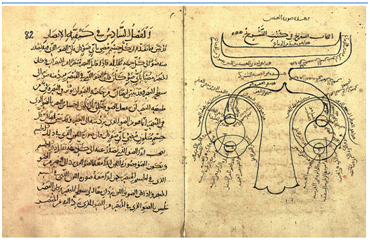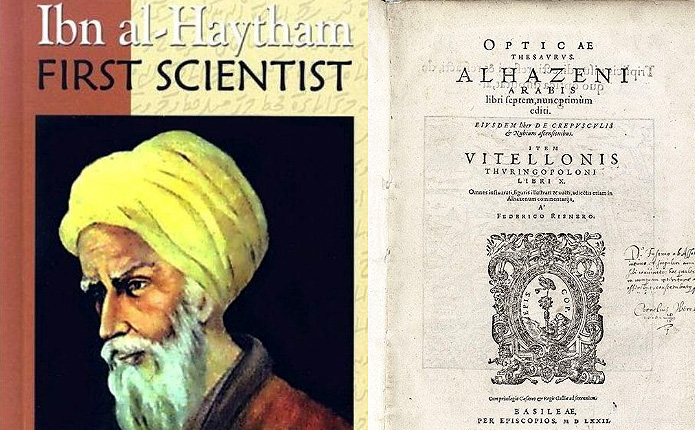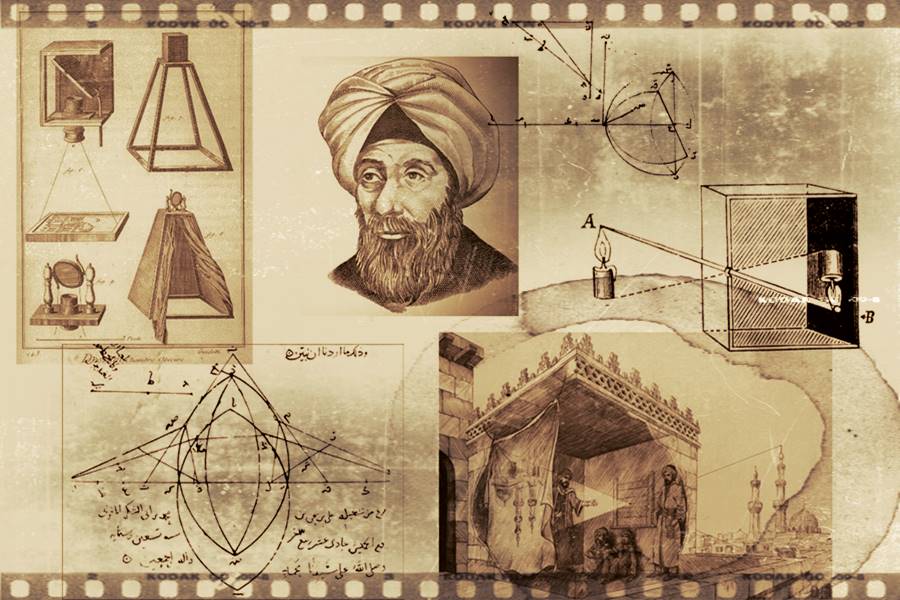Thu 25 February 2021:
Ibn Al-Haytham (known in the west as Alhazen) which is considered to be the greatest Muslim doctor and one of the greatest researches of optics for all times. Al Haytham is born in city Basra and immigrated to Egypt during reign of Caliph Al Hakim. He is quoted as excellent astronomer, mathematician and doctor as well as one of the best commentators of the Galen and Aristotle’s work.
He is the first medical scholar who teaches that light “does not originates from the eye but on opposite enters the eye”, and in that manner corrects the wrong opinion of the Greeks about the nature of vision. According to this scholar retina is the center of vision and the impressions that it receives are transferred to the brain by the optical nerve, in order that brain afterwards create visual image in the symmetrical relationship for both retinas.
Al-Haytham was the most important researcher of optics. He was convinced that the adequate theory of vision must combine Euclid and Ptolemy “mathematical” approach and “physical doctrine of the naturalists. The result of his reflections in the paper “Optics”, supported by the experimental approach, is the new theory of vision, much richer and perfected than any before. He thought that light and color, two physical features that exist independently from the observed subject, in strait lines originates from each point of visible object.
Al Haytham concludes that what we perceive is actually the object which is on a certain distance from the eye and which have certain shape and size, and vision itself is the result of intervention by the visual material received by the brain and stored information’s from previous experiences. Reception hypothesis (intromission) Al-Haytham exposed to mathematical testing, and then incorporated into already developed perception theory, which is still not completely explored by historians.
In his experiments he used “dark chambers”, trying to confirm the features of light, such as expansion in straight lines, reflexion and refraction of the light beams. Basic stand point which he supported was that the vision is the result of impression which light leaves on the sight sense, he supported it based on the experience that the eye “retains an image” or has pain when looking into bright light. Theory of vision by Haytham Optics, written in Egypt during the first half of XI century, overmatches Galen, Euclid and Ptolemy ones. [1]
Hasan Ibn al-Haytham (Alhazen) was Born in 965 CE in Basra, Iraq and Died in 1040 CE in Cairo, Egypt. He resided in Basra and Cairo. He is also called “Basri” after his native place. He held a position with the title vizier in his native Basra, and made a name for himself for his knowledge of applied mathematics.
He is Known for Book of Optics, Doubts Concerning Ptolemy, Alhazen’s problem, Analysis, Catoptrics, Horopter, Moon illusion, experimental science, scientific methodology, visual perception, empirical theory of perception, Animal psychology.
Scientific career
He is known in the fields of Optics, Astronomy, and Mathematics who made significant contributions to the principles of optics and the use of scientific experiments.
He was Influenced by Aristotle, Euclid, Ptolemy, Galen, Banu Mūsā, Thābit ibn Qurra, Al-Kindi, Ibn Sahl, Abū Sahl al-Qūhī.
Hasan Ibn al-Haytham (Alhazen) Influenced Omar Khayyam, Taqi ad-Din Muhammad ibn Ma’ruf, Kamāl al-Dīn al-Fārisī, Averroes, Al-Khazini, John Peckham, Witelo, Roger Bacon, Kepler.
Hasan Ibn al-Haytham (Latinized Alhazen) has a full name Abū ʿAlī al-Ḥasan ibn al-Ḥasan ibn al-Haytham ( 965 CE – 1040 CE) was an Arab mathematician, astronomer, and physicist of the Islamic Golden Age. Sometimes called “the father of modern optics”, he made significant contributions to the principles of optics and visual perception in particular, his most influential work being his Kitāb al-Manāẓir (“Book of Optics”), written during 1011–1021, which survived in the Latin edition. It was translated into Latin as Opticae thesaurus Alhazeni in 1270. A polymath, he also wrote on philosophy, theology and medicine.
Ibn al-Haytham grew up at a time when schools and libraries flourished in the Muslim civilization. Students had access to highly trained scholars who could teach a variety of subjects, including law, literature, medicine, mathematics, geography, history and art. Debates and discourses were popular and took place in Arabic. Scholars enjoyed discussing ideas from newly translated ancient manuscripts. [2]
Ibn al-Haytham was the first to explain that vision occurs when light bounces on an object and then is directed to one’s eyes. He was also an early proponent of the concept that a hypothesis must be proved by experiments based on confirmable procedures or mathematical evidence – hence understanding the scientific method five centuries before Renaissance scientists.
Although born in Basra, he spent most of his productive period in the Fatimid capital of Cairo and earned his living authoring various treatises and tutoring members of the nobilities.
In medieval Europe, Ibn al-Haytham was honored as Ptolemaeus secundus (the “Second Ptolemy”) or simply “The Physicist”. Ibn al-Haytham paved the way for the modern science of physical optics. [3]
Ibn al-Haytham moves to Cairo [2]
He is known to have said, “If I would be given the chance, I would implement a solution to regulate the Nile flooding”. This claim reached al-Hakim, the Fatimid caliph in Egypt who invited him to Cairo. Confident of his own abilities, Ibn al-Haytham boasted that he would tame the great Nile River by building a dam and reservoir.
But when he saw the extent of the challenge and the marvelous remains of ancient Egypt on the river banks, he reconsidered his own boast thinking. If such a huge project could be done, he reasoned, it would have been done by the brilliant builders of the past who had left us such fantastic architectural relics. He returned to Cairo to inform the caliph that his solution was not possible.
Knowing that al-Hakim the caliph did not entertain failure and that his life would be at risk if he were to disappoint him, Ibn al-Haytham feigned madness to avoid the caliphs’ wrath. He knew that Islamic law would protect a mad person from bearing responsibility for his failure. Despite the caliph’s wild swings of mood, he nevertheless abided by Islamic law. Rather than executing or expelling Ibn al-Haytham from Cairo, the caliph decided to put the scholar under permanent protective custody. That was required by law in order to ensure his safety and that of others. Ibn al-Haytham was placed under what amounted to house arrest, far from the lively discourses and debates to which he was accustomed.
Yet it just as life was at its bleakest moment, Ibn al-Haytham might have made the dazzling discovery for which he is best remembered. Legend says, one day he saw light shining through a tiny pinhole into his darkened room – projecting an image of the world outside onto the opposite wall. Ibn al-Haytham realized that he was seeing images of objects outside that were lit by the Sun. From repeated experiments he concluded that light rays travel in straight lines, and that vision is accomplished when these rays pass into our eyes. (Fig. 1)
Ibn al-Haytham confirmed his discovery by experimenting with his dark room (calling it Albait Almuzlim)- translated into Latin as camera obscura, which simply means “dark room”.
After many additional experiments using special apparatus of lenses and mirrors which he built, he laid down his new ideas about light and vision in his seven volumes Book of Optics. He was released from prison on the death (disappearance) of the caliph.
According to al-Qifti, ibn al-Haytham lived for the rest of his life near the al Azhar Mosque in Cairo writing mathematics texts, teaching and making money by copying texts. Since the Fatimids founded the University of Al-Azhar based on this mosque in 970, ibn al-Haytham must have been associated with this center of learning. [4]
From his observations of light entering a dark room, he made major breakthroughs in understanding light and vision. His discoveries led him to make significant revision to ancient views about how our eyes see. Through his studies of earlier work by Galen and others, he gave names to several parts of the eye, such as the lens, the retina and the cornea. He set new standards in experimental science and completed his great Book of Optics sometime around 1027. [2]
So how did that influence shine its light on later generations? In the early 12th century, Toledo in Spain was the focus of a huge effort to translate Arabic books into Latin. Christian, Jewish and Muslim scholars flocked to the city, where they lived alongside one another and worked together to translate the old knowledge into Latin and then into other European languages. Ibn al-Haytham’s Book of Optics as well as some of his other scientific works were translated into Latin making them available to European scientists including Roger Bacon, Johannes Kepler and even Leonardo da Vinci. [2]
How Ibn al-Haytham changed the course of science [2]
Ibn al-Haytham’s discoveries in optics and vision overturned centuries of misunderstanding. In his experiments, he observed that light coming through a tiny hole travelled in straight lines and projected an image onto the opposite wall. (Fig. 1)
But he realized that light entering the eye was only the first step in seeing. He built on the work of Greek physician Galen who had provided a detailed description of the eye and the optic pathways. Today the oldest-known drawing of the nervous system is from Ibn al-Haytham’s Book of Optics, in which the eyes and optic nerves are illustrated.

Ibn al-Haytham suggested that only the light rays that hit the surface of the eye head-on would pass into the eye, creating a representation of the world. It was Kepler in the sixteenth century who corrected this and proposed that the object of sight – what is seen comes from both perpendicular and angular rays that hit the eye to form an inverted image on the retina.
Among Ibn al-Haytham’s other insights was his understanding of the crucial role of visual contrast. For example, he realized the color of an object depends on the color of the surroundings, and that a contrast of brightness levels explains why we can’t see the stars during daytime.
Ibn al-Haytham also subscribed to a method of empirical analysis to accompany theoretical postulates that is similar in certain ways to the scientific method we know today. He realized that the senses were prone to error, and he devised methods of verification, testing and experimentation to uncover the truth of the natural phenomena he perceived. Up until this time, the study of physical phenomena had been an abstract activity with occasional experiments.
In search of evidence, Ibn al-Haytham studied lenses, experimented with different mirrors: flat, spherical, parabolic, cylindrical, concave and convex. His practical results were clear:
“Visual objects seen by us through light refraction – across thick material such as water and glass – are bigger than their real size”, he wrote.
After his death, Ibn al-Haytham’s writings were more influential in Latin than Arabic. The only significant work in Arabic that built on Ibn al-Haytham’s ideas was produced in the early part of the fourteenth century (in present day Iran) by Kamal al-Din al-Farisi, who was himself a brilliant scientific thinker.
When Ibn al-Haytham’s Book of Optics was translated into Latin it had great influence and was widely studied/read. It was published as a print edition in 1572 by Friedrich Risner with the title Opticae thesaurus so that it could be made more easily available. The Polish astronomer Johannes Hevelius chose to honour Ibn al-Haytham, alongside Galileo, in his most famous work on the Moon, Selenographia, published in 1647.
Some questions Ibn al-Haytham raised remained unsolved for a thousand years. One such was called ‘Alhazen’s problem’ for which he offered a geometrical solution: “Given a light source and a spherical mirror, find the point on the mirror where the light will be reflected to the eye of an observer”. Ibn al-Haytham solved this problem geometrically but it remained unsolved using algebraic methods until it was finally solved in 1997 by the Oxford mathematician Peter M Neumann.
And yet, some mysteries remain. Ibn al-Haytham affirmed that an optical illusion was the reason for the Moon appearing so big when it’s low in the sky close to the horizon in comparison to its size when at the zenith- and still no one knows why this happens. This, and other questions in science, has yet to be solved – leaving a legacy of intrigue for us to tackle today. [2]
Books of Alhazen
Book of Optics was translated into English : Thesaurus of Optics: seven books of the Arab Alhazeni, first edition: concerning twilight and the advancement of clouds. Risner is also the author of the name variant “Alhazen”; before Risner he was known in the west as Alhacen. This work enjoyed a great reputation during the Middle Ages. Works by Alhazen on geometric subjects were discovered in the Bibliothèque nationale in Paris in 1834 by E. A. Sedillot. In all, A. Mark Smith has accounted for 18 full or near-complete manuscripts, and five fragments, which are preserved in 14 locations, including one in the Bodleian Library at Oxford, and one in the library of Bruges. [3]

Through his Book of Optics (Kitab al-Manazir) and its Latin translation (De Aspectibus), his ideas influenced European scholars including those of the European Renaissance. Today, many consider him a pivotal figure in the history of optics and the “Father of modern Optics”.
Ibn al-Haytham was born during a creative period known as the golden age of Muslim civilization that saw many fascinating advances in science, technology and medicine. In an area that spread from Spain to China, inspirational men and women, of different faiths and cultures, built upon knowledge of ancient civilizations, making discoveries that had a huge and often underappreciated impact on our world. [5]
Out of the 96 books he is recorded to have written; only 55 are known to have survived. Those related to the subject of light included: The Light of the Moon, The Light of the Stars, The Rainbow and the Halo, Spherical Burning Mirrors, Parabolic Burning Mirrors, The Burning Sphere, The Shape of the Eclipse, The Formation of Shadows, Discourse on Light, as well as his masterpiece, Book of Optics. Latin translations of some of his works are known to have influenced important Medieval and European Renaissance thinkers like Roger Bacon, René Descartes and Christian Huygens, who knew him as “Alhazen”. [2]
Major works
Ibn al-Haytham’s most important work is Kitāb al-manāẓir (“Optics”). Although it shows some influence from Ptolemy’s 2nd century ad Optics, it contains the correct model of vision: the passive reception by the eyes of light rays reflected from objects, not an active emanation of light rays from the eyes. It combines experiment with mathematical reasoning, even if it is generally used for validation rather than discovery.
The work contains a complete formulation of the laws of reflection and a detailed investigation of refraction, including experiments involving angles of incidence and deviation. Refraction is correctly explained by light’s moving slower in denser mediums. The work also contains “Alhazen’s problem” – to determine the point of reflection from a plane or curved surface, given the center of the eye and the observed point – which is stated and solved by means of conic sections. Other optical works include Ḍawʾ al-qamar (“On the Light of the Moon”), al-Hāla wa-qaws quzaḥ (“On the Halo and the Rainbow”), Ṣūrat al-kusūf (“On the Shape of the Eclipse”; which includes a discussion of the camera obscura), and al-Ḍawʾ (“A Discourse on Light”). [6]
Number theory
Alhazen’s contributions to number theory include his work on perfect numbers. In his Analysis and Synthesis, he may have been the first to state that every even perfect number is of the form 2n−1(2n − 1) where 2n − 1 is prime, but he was not able to prove this result; Euler later proved it in the 18th century. Alhazen solved problems involving congruences using what is now called Wilson’s theorem. In his Opuscula, Alhazen considers the solution of a system of congruences, and gives two general methods of solution. His first method, the canonical method, involved Wilson’s theorem, while his second method involved a version of the Chinese remainder theorem. [3]
Calculus
Alhazen discovered the sum formula for the fourth power, using a method that could be generally used to determine the sum for any integral power. He used this to find the volume of a paraboloid. He could find the integral formula for any polynomial without having developed a general formula.[3]
Scientific method
The duty of the man who investigates the writings of scientists, if learning the truth is his goal, is to make himself an enemy of all that he reads, and … attack it from every side. He should also suspect himself as he performs his critical examination of it, so that he may avoid falling into either prejudice or leniency. [3]
He contributed to Astronomy, Celestial Physics, Mechanics, On the Configuration of the World, Geometry, Engineering, Philosophy and Theology.(Fig. 2)
Ibn al Haytham – The First Scientist (Fig. 3)
ibn al-Haytham was the first person to test hypotheses with verifiable experiments, developing the scientific method more than 200 years before European scholars learned of it – by reading his books.
He turned his attention to the works of the ancient Greek philosophers and mathematicians, including Euclid and Archimedes. He completed the fragmentary Conics by Apollonius of Perga. Ibn al-Haitham was the first person to apply algebra to geometry, founding the branch of mathematics known as analytic geometry.
In his massive study of light and vision, Kitâb al-Manâzir (Book of Optics ), Ibn al-Haytham submitted every hypothesis to a physical test or mathematical proof. To test his hypothesis that “lights and colors do not blend in the air,” for example, Ibn al-Haytham devised the world’s first camera obscura, observed what happened when light rays intersected at its aperture, and recorded the results. Throughout his investigations, Ibn al-Haytham followed all the steps of the scientific method. Bradley Steffens wrote Ibn al-Haytham: First Scientist, the world’s first biography of the Muslim polymath. (Fig. 3)
Honors
The impact crater Alhazen on the Moon is named in his honour, as was the asteroid 59239 Alhazen. In honour of Alhazen, the Aga Khan University (Pakistan) named its Ophthalmology endowed chair as “The Ibn-e-Haitham Associate Professor and Chief of Ophthalmology”. Alhazen, by the name Ibn al-Haytham, is featured on the obverse of the Iraqi 10,000-dinar banknote issued in 2003, and on 10-dinar notes from 1982.
The 2015 International Year of Light celebrated the 1000th anniversary of the works on optics by Ibn Al-Haytham. [3]
Commemorations
In 2014, the “Hiding in the Light” episode of Cosmos: A Spacetime Odyssey, presented by Neil deGrasse Tyson, focused on the accomplishments of Ibn al-Haytham. He was voiced by Alfred Molina in the episode.
Over forty years previously, Jacob Bronowski presented Alhazen’s work in a similar television documentary (and the corresponding book), The Ascent of Man. In episode 5 (The Music of the Spheres), Bronowski remarked that in his view, Alhazen was “the one really original scientific mind that Arab culture produced”, whose theory of optics was not improved on till the time of Newton and Leibniz.
UNESCO declared 2015 the International Year of Light and its Director-General Irina Bokova dubbed Ibn al-Haytham ‘the father of optics’. Amongst others, this was to celebrate Ibn Al-Haytham’s achievements in optics, mathematics and astronomy. An international campaign, created by the 1001 Inventions organization, titled 1001 Inventions and the World of Ibn Al-Haytham featuring a series of interactive exhibits, workshops and live shows about his work, partnering with science centers, science festivals, museums, and educational institutions, as well as digital and social media platforms. The campaign also produced and released the short educational film 1001 Inventions and the World of Ibn Al-Haytham, In honour of Alhazen, the Aga Khan University (Pakistan) named its Ophthalmology endowed chair as “The Ibn-e-Haitham Associate Professor and Chief of Ophthalmology” [3]
Legacy
Alhazen made significant contributions to optics, number theory, geometry, astronomy and natural philosophy. Alhazen’s work on optics is credited with contributing a new emphasis on experiment. Alhazen is popularly known as the first scientist, developed the scientific method of experimentation and was the first person to formulate hypothesis and conduct verifiable experiments. Alhazen’s scientific knowledge was extensive. He wrote over a hundred books, more than half of which have been preserved. [3]
Alhazen made major contributions to physics, mathematics and astronomy as well. He developed the field of analytical geometry by exploring the connection between algebra and geometry. He studied the atmosphere and deduced the relationship between its density and height, which according to him was 55 miles. He devised one of the first laws of motion and suggested that an object in motion will remain in a perpetual state of motion unless it is influenced by an external force that causes it to stop or change its direction.
In astronomy he studied the anomalies between Aristotelian and Ptolemaic models and wrote his own treatise called “On the Structure of the World”. Alhazen was undoubtedly one of the finest and earliest Muslim scholars of note and his work influenced many notable scientists and scholars who came after him such as Leonardo Da Vinci, Galileo, Descartes and Kepler, to name a few. [7]

Fig. 1. Pinhole Camera demonstration by Ibn al Haytham. The use of a pinhole in a window blind to form an inverted image of an outside scene on an opposite wall of a dark room has been known since at least the time of the Arab scholar Ibn al Haytham(or Alhazen, ca. 956- 1038).[8]
Fig. 2. Achievements of Ibn al-Haytham (Alhazen) [9]

Fig. 3. Bradley Steffens wrote Ibn al-Haytham: First Scientist, the world’s first biography of the Muslim polymath. [10]
References:
- Med Arh. 2008;62(3):183-8. https://www.ncbi.nlm.nih.gov/pubmed/18822953
- http://www.ibnalhaytham.com/discover/who-was-ibn-al-haytham/
- https://en.wikipedia.org/wiki/Ibn_al-Haytham
- http://www-history.mcs.st-andrews.ac.uk/Biographies/Al-Haytham.html
- http://www.ibnalhaytham.com/
- https://www.britannica.com/biography/Ibn-al-Haytham
- https://www.famousinventors.org/alhazen
- https://religiondocbox.com/Islam/71545455-1001-inventions-exhibition-at-the-science-museum-london.html
- https://docs.google.com/presentation/d/1cgLK8EhmxxgkcjStM018Y53nIfznqVFqLfh2mhUJ_kM/edit#slide=id.p14
- http://www.firstscientist.net/
Submitted by Professor Ibrahim B. Syed
Article Originally Published in historyofislam CLICK HERE

FOLLOW INDEPENDENT PRESS:
TWITTER (CLICK HERE)
https://twitter.com/IpIndependent
FACEBOOK (CLICK HERE)
https://web.facebook.com/ipindependent
Think your friends would be interested? Share this story!






